The first armored cars of Bianchi (Italy)
The authors of the new project, by the year of creation, received the designation Mod.1912, decided to follow the simplest way to create an armored vehicle. It was decided to take the chassis of the Bianchi serial commercial truck and install a special protected hull on it. This approach was used in the most active way for a long time, because it allowed to reduce the costs of developing and building serial equipment. In addition, until a certain time, most developers of armored vehicles simply did not have the opportunity to develop chassis from scratch specifically for new armored vehicles.
The chassis of a truck with a wheel formula 4 x2 was taken as the basis for a promising armored car. The basic Bianchi truck had a layout that was typical for a similar vehicle of the time. In front of the frame was installed engine and gearbox. Bottom springs and bridges were attached to the frame below. The car was equipped with a gasoline engine and manual transmission. A drive shaft went along the frame, which set the rear wheels in motion. The front wheels were driven.
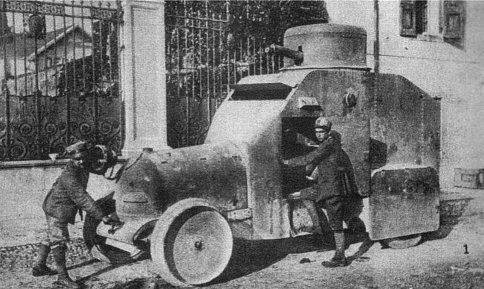
Bianchi Mod.1912 armored car
For the development of the armored body of the machine was responsible Baron Antonio de Marchi. He offered his own version of the armored hull design, which, nevertheless, resembled a similar design by Isotta Fraschini. Due to certain reasons, the armored cars “Izotta-Fraschini” Mod.1911 and “Bianchi” Mod.1912 were very similar in appearance, which can lead to some confusion. Anyway, the project de Marchi was further developed, the result of which was a serious change in the appearance of the car.
During the construction of the first Bianchi Mod.1912 armored vehicles, the base truck chassis underwent minimal changes. With it removed all the extra parts and installed some new ones. In particular, it was decided to leave the single rear wheels. In this case, the tires were replaced by tubeless, and the front wheels were equipped with additional rims that improve throughput.
The armored hull of the car was proposed to be assembled from sheets of 6 mm thickness, on rivets mounted on a metal frame. The body consisted of two main parts. The front is a relatively small part of the body accommodates the engine and gearbox, and the rear large was a total habitable volume, combining the control compartment and the fighting compartment. A similar layout of the body soon became a classic for armored cars around the world.
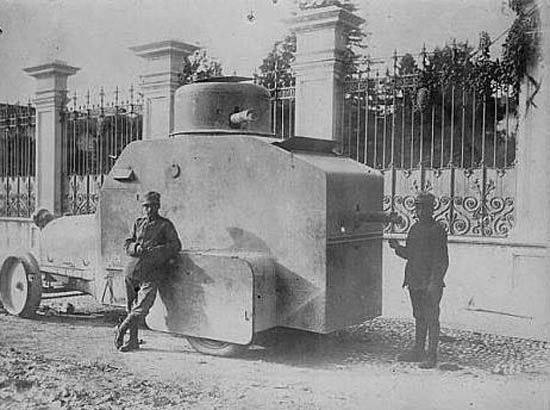
Bianchi Mod.1912 armored car
The armored hood of the engine had a straight front wall with hacked blinds. Its main part had a rounded shape and hatches for access to the internal units. Apparently, this design of the hood was too complicated, which is why in the updated versions of the project a modified engine compartment was proposed.
Directly behind the engine compartment, the armored car hull expanded, its height also increased. The upper frontal sheet of the habitable body volume was located at an angle to the vertical. There were also two sloping cheekbones of the hull sides. Placed at angles to the horizontal and vertical sheets allowed to ensure the correct pairing of two compartments with different sizes, and in addition, to a certain extent, increase the level of protection of the frontal projection.
In the inclined front hull there was a wide hatch to observe the road. In a combat situation, it should be closed with a lid with a viewing slot. In addition, two smaller slots were provided in the front of the sides, which made it possible to observe the space on the side of the car.
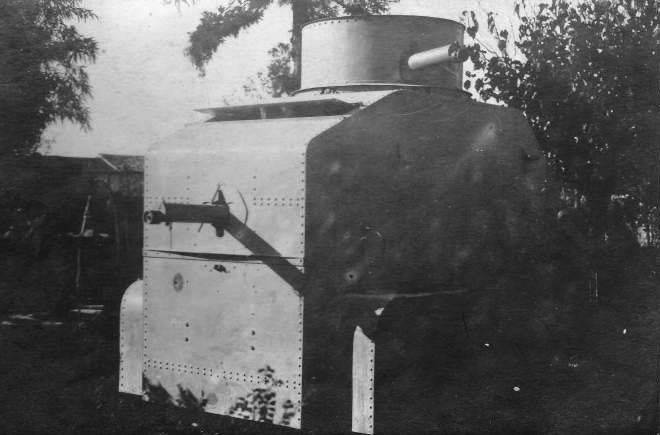
Armored car Bianchi Mod.1912, rear view. Clearly visible fodder machine gun
The sides of the hull were made of several flat metal sheets and were arranged vertically. A vertical feed sheet was also envisaged. The hull roof and the stern leaf were connected by an inclined leaf with another wide viewing hatch. On the sides, in the stern of them, two metal boxes were installed, which served to protect the rear wheels. Similar details have already been used in the project of the company “Izotta-Fraschini”.
The crew of the armored vehicle Bianchi Mod.1912 was to consist of three people. The driver was located in the front of the habitable volume, two arrows - in the center and aft of the hull. At the disposal of the shooters were two machine guns. One of them was located in a rotating cylindrical tower with a roof and a hatch in it. The second machine gun was placed in the embrasure of the hull's stern sheet. Thus, one shooter could control the entire surrounding space, and the second fired a wide sector behind the car, controlling it with the help of a viewing hatch or a slot in the lid. Get into the car followed through the door in the left side.
The resulting armored car weighed about 3 tons and on a good road could reach speeds of up to 25-30 km / h. Due to the lack of experience in creating and operating such equipment, such characteristics were considered sufficient.
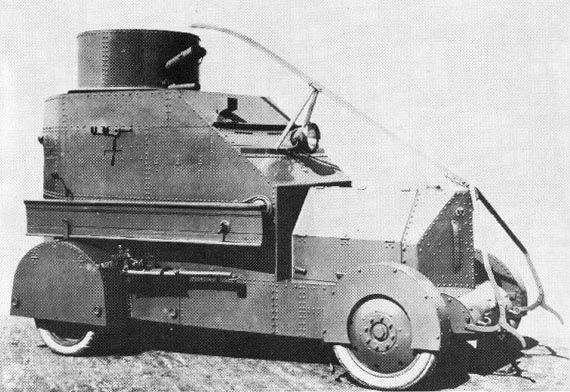
Bianchi Mod.1915 armored car
The development of the new armored car project was completed in the first half of 1912 of the year. Soon the construction of the first prototype began. As follows from the available information, the armored car Bianchi Mod.1912 was tested only by the fall, because of which he did not have time to go to war. By this time, several new Italian-made armored cars were sent to Libya, but the Bianchi car was not included in their number.
The Italo-Turkish War ended in October 1912. The armored cars used in the battles were returned to Italy, and the only prototype Bianchi Mod.1912 stood idle at the factory. This machine was of no interest to the potential customer in the face of the Italian army, because of which the project could be safely closed.
However, the Italian engineers did not abandon further development, as it seemed, a promising project. Over the next few years, the Bianchi specialists and Baron de Marchy continued to put forward and discuss new ideas that should be introduced into the existing project. However, as far as is known, until a certain time no one took these works seriously. The army did not show interest in new armored cars, and the absence of armed conflicts had a negative impact on the progress of military equipment projects.
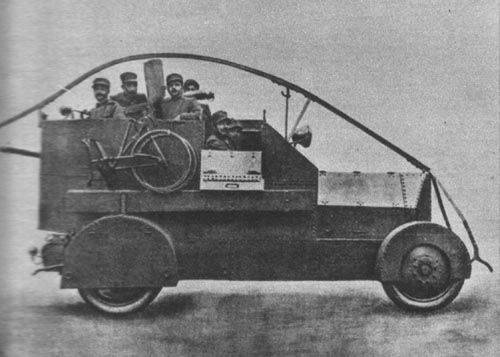
Bianchi Mod.1916 armored car
World War I began in 1914, but Italy was in no hurry to join the warring countries. Without waiting for the entry of his country into the war, Italian engineers began to create new equipment and modernize the old one. By this time, the firm Bianchi already had a general idea of the approximate ways to update their project. The result was the appearance of another version of the Mod.1912 armored car. At the beginning of the 1915 of the year, a modernized armored car came out, also called by the year of production. The new Mod.1915 was seriously different from the base Mod.1912.
The new armored vehicle was based on the same chassis as the previous one, but had a different hull design. According to the research it was decided to protect the chassis frame with armor, install protective covers on the front wheels, and also make the rear covers smaller and lighter. In addition, now in the design of the protection of the engine compartment there were no curved parts. The new hood consisted of two frontal parts of a pentagonal shape, two vertical sides of a small height and inclined roof sheets connected to a narrow horizontal beam at the top. For servicing the engine, inclined side plates could be hinged up on the hinges.
The upgraded body had no cheekbones between the engine compartment and the habitable compartment. Instead, the gap between the sides of the hood and the habitable volume was covered with a vertical sheet, located across the longitudinal axis of the machine. As before, an inclined front sheet was provided with an inspection hatch of a new design. Under the hatch was a headlight for movement in the dark. The Mod.1912 had straight vertical sides and a wedge-shaped aft part. On the roof remained a cylindrical tower with a machine gun. For access to the fighting compartment there was a door in the port side.
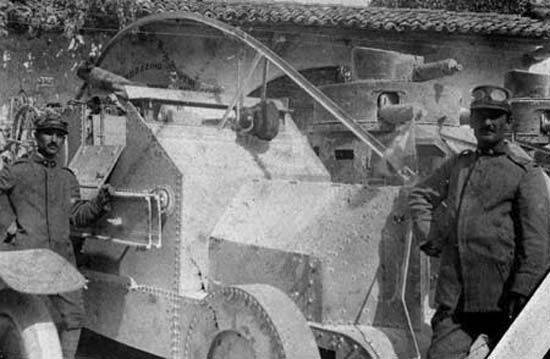
Armored car Bianchi Mod.1916. Noticeable lack of shield machine gun
The crew, as before, consisted of three people. To attack the enemy it was proposed to use two machine guns: one in the tower and one in the aft embrasure. Due to the lack of a slanted stern sheet, the machine gunner had to rely only on the available viewing instruments and sight.
Tests of the Bianchi Mod.1911 armored car showed that the additional rims on the front wheels do not provide particular advantages when moving on soft soils. For this reason, the new project abandoned such details. Among other things, it allowed the use of relatively narrow and, accordingly, lighter front wheel covers. It was proposed to pull out the machine “stuck” in the dirt with a special tray-rail. This device was mounted on the right side of the hull.
The new armored car was supposed to work on the battlefields of the First World War with numerous wire obstacles. To overcome them, the car received a special frame mounted on the upper part of the body. Before the hood, the frame forked and had the shape of the letter "L". It was assumed that the hooks-guides of this part of the frame, installed at an angle to the vertical, would lift the wire and carry it over the long curved rail located above the roof of the case. Further, due to the movement of the car had to raise the barrier and pass it on the frame, not clinging to the elements of the chassis and other details.
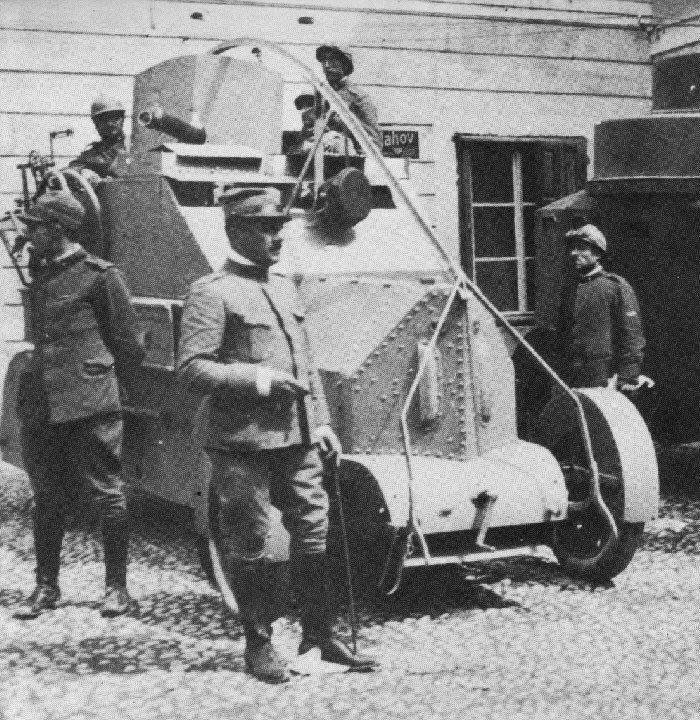
Bianchi Mod.1916 armored car
About a year after the Bianchi Mod.1915 armored car, a car appeared with the Mod.1916 index. It was a slightly modified version of its predecessor. The main and most notable difference was the absence of the roof of the hull and the tower. It was decided to make the fighting compartment of the car open. Armament still consisted of two machine guns. At the same time, one of them, due to the abandonment of the tower, was mounted on a special turret above the combat compartment. From the bullets of the enemy, the arrow covered the armor shield. According to some reports, the shield could be removed, or not installed at all. This may explain the existence of photographs showing the Mod.1916 armored car without a shield.
According to reports, for several years, the company "Bianchi" built a total of four armored vehicles of three types. The exact number of vehicles of each model is unknown, but the existing information suggests that there were one copy of the armored vehicles Mod.1912 and Mod.1915, and Mod.1916 was built in the amount of two units.
Italy entered the First World War in May 1915. In the battles, we had to use almost all the military equipment available at that time, including prototypes of promising vehicles. Bianchi armored cars are no exception. All four cars (or three, except the oldest) were used in various battles during 1915-16's.
During the First World War, armored cars repeatedly had a decisive influence on the course of the battle. Such equipment in practice demonstrated its real capabilities and caused serious damage to the enemy. The experience of the combat use of armored cars "Bianchi" was taken into account by the Italian command, resulting in the development of this class of technology continued. Soon in Italy were created several new projects of armored vehicles with machine guns.
Based on:
http://aviarmor.net/
http://warwheels.net/
http://cimeetrincee.it/
Bartholomew E. Early Armored Cars. Oxford, UK. Shire Publications Ltd, 1988
- Ryabov Kirill
- Aviarmor.net
Information